Terry L. Ettinger Horticulture Consulting Services
Meeting The Needs Of Today With A Vision For The Future
Special Topics
Worst Weeds in Landscape Plantings
Integrated Strategy is Key to Control
Eliminating the invasive weeds featured here isn’t easy. In fact, you may never be able to rid your property of them completely.
However, by following the steps outlined below - combined with a lot of patience (the ultimate virtue of every gardener) - you can at least reduce infestations of these weeds to manageable levels.
Prevention and Detection
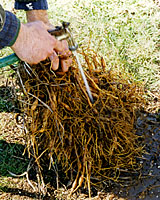 Be careful when accepting divisions from a friend’s garden as the soil surrounding the roots of the “gift” can harbor
invasive weeds. The best way to avoid this mode of infestation is to
wash the soil - and any weed seed and/or root pieces - from the
roots of the gifts before planting them in your garden, at left. For more
information on how to do this, click
here.
Be careful when accepting divisions from a friend’s garden as the soil surrounding the roots of the “gift” can harbor
invasive weeds. The best way to avoid this mode of infestation is to
wash the soil - and any weed seed and/or root pieces - from the
roots of the gifts before planting them in your garden, at left. For more
information on how to do this, click
here.
This caution also extends to the rootballs and containers of nursery-grown trees, shrubs and perennials. Even though these
plants may come from a
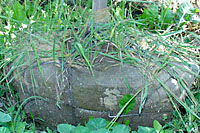 reputable local garden center, invasive weeds buried deep within the rootball may not appear for weeks,
or even months after you add the plant to your landscape!
reputable local garden center, invasive weeds buried deep within the rootball may not appear for weeks,
or even months after you add the plant to your landscape!
Also, be very wary of “topsoil.” I’ve visited many properties where landscape beds have been overrun by weeds that arrived in infested topsoil!
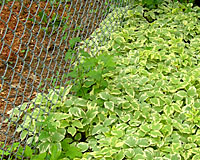 And, make sure to patrol the edges of your property. If you’re battling a property-straddling
infestation, at left, you'll
win the war only if you and your neighbor work together to remove the weed from both properties.
And, make sure to patrol the edges of your property. If you’re battling a property-straddling
infestation, at left, you'll
win the war only if you and your neighbor work together to remove the weed from both properties.
Starvation
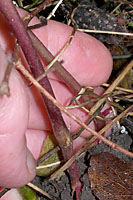 After securing your property from weed infestations, start starving existing infestations by constantly cutting the stems
and vines of these weeds to the ground from spring through mid-August,
at right.
After securing your property from weed infestations, start starving existing infestations by constantly cutting the stems
and vines of these weeds to the ground from spring through mid-August,
at right.
Without leaves, these weeds can’t make plant food (simple sugars and starches) through the process of photosynthesis. They’ll also use up food they’ve stored in their roots and rhizomes as they try to replace stems and vines that you keep cutting off!
Delivering the Fatal Blow
After starving these invasive weeds by keeping them cut close to the ground all summr, let them grow from mid-August to mid-September. Cutting them down all summer will make them less vigorous in September than they were in April. And, in response to shorter days and cooler temperatures, they’ll be translocating photosynthetic products as fast as possible from the leaves you’ve allowed them to form since the middle of August, down into their root system in preparation for the winter ahead.
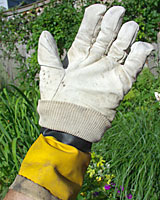 This combination of rapid translocation and weakened physical condition will increase the susceptibility of Japanese
bamboo, goutweed and the bindweeds to applications of herbicides such as Roundup, Brush-B-Gon, etc. between the middle of
September and the first killing frost. When growing among and/or on
desirable plants in landscape beds, the best way to apply these
herbicides may be to use a
"glove-in-glove" technique, at left.
This combination of rapid translocation and weakened physical condition will increase the susceptibility of Japanese
bamboo, goutweed and the bindweeds to applications of herbicides such as Roundup, Brush-B-Gon, etc. between the middle of
September and the first killing frost. When growing among and/or on
desirable plants in landscape beds, the best way to apply these
herbicides may be to use a
"glove-in-glove" technique, at left.
Horsetail is also weakened by repeated defoliation. However, it’s sensitive to only two herbicides. Casoron (dichlobenil), a granular herbicide, can be applied around some established trees and shrubs, but not perennials, between November and March. Meanwhile, Manage (halosulfuron-methyl), a liquid herbicide, can be sprayed directly on young foliage as it regrows in September and/or emerges in April and May. Both of these herbicides can be applied only by certified pesticide applicators.
Finally, infestations of yellow nutsedge can be eliminated over the course of several years by preventing tuber formation. Do this by pulling up young plants or wiping them with Roundup, Kleenup, or other glyphosate-containing herbicide as soon as they sprout in May or early June before new tubers start forming in July. When applied by a certified pesticide applicator, Manage herbicide will also control this annoying, invasive weed.